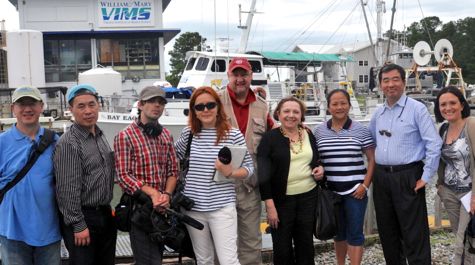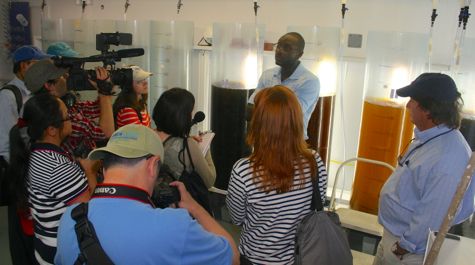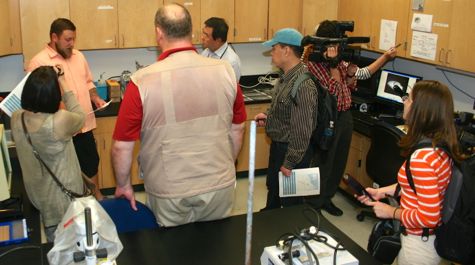U.S. State Department brings foreign journalists to VIMS
Scientists answer questions about sustainable use of marine resources
Ana Coman has reported on the status of Roma immigration to the U.S. He Xiaoyan recently wrote about a Chinese student who was injured in the Boston bombings. Antonella Ciancio covers the performance of the Italian fashion house Versace in U.S. markets.
Last week, these and five other foreign journalists boarded a Virginia Institute of Marine Science skiff to brave a York River chop on their way to a local oyster farm. The boat trip was part of a daylong visit to VIMS organized by the Washington Foreign Press Center (FPC), an office of the U.S. Department of State responsible for helping foreign-based journalists report on American society, politics, and culture.
Participating in the visit were Weihua Chen and Chenbei Sun of China Daily, China’s largest English-language newspaper; Antonella Ciancio, a multimedia reporter with the Italian online newspaper Linkiesta; Ana Coman of Romanian Radio Broadcasting; Octavian Coman of the Romania weekly magazine Dilema Veche; Alena Taranova of Slovakia Public TV and Radio; and Xian Wen and He Xiaoyan of People’s Daily, China’s official news outlet. State Department officials Miriam Rider and David Benton initiated the outing.
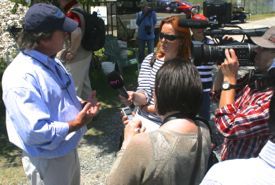
Rider says the visit is part of a broader FPC program to inform foreign journalists about U.S. efforts to study and encourage sustainable use of oceans, water, and fishing resources. Secretary of State John Kerry recently announced an international oceans conference that will take place this fall to promote global actions to better address pollution, overfishing, acidification, and other ocean threats, and to move the world’s oceans toward a sustainable future.
“Whether we’re talking about trade, or climate, or security, or sustainable food sources,” says Kerry, “there can be no doubt that the oceans deserve our focus. The international oceans conference [will allow us to] further explore these issues and work toward shared solutions.”
An international perspective
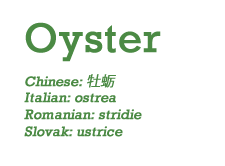
During their visit to VIMS, the foreign reporters were introduced to the Institute’s three-part mission of research, education, and advisory service, with tour stops and presentations highlighting several programs with direct impact on ocean sustainability. An underlying theme was oyster breeding and aquaculture, with stops in the VIMS Oyster Hatchery, the Chesapeake Bay Foundation’s oyster restoration site on VIMS’ Gloucester Point campus, and a trip to Chessie Seafood and Aquafarms, a local oyster operation owned and run by VIMS alumnus Tommy Leggett.
Helping to host the tour was Dr. Mark Luckenbach, Associate Dean for Research and Advisory Services at VIMS. He says, “It was fascinating to hear the international perspective that the reporters brought to the topics we discussed—from fisheries management to nutrient pollution and sea-level rise—and daunting to be reminded that the challenges we face here in Chesapeake Bay also affect coastal zones around the world.”
VIMS Dean and Director John Wells says “The reporters’ visit provided a good opportunity to talk about these global threats to ocean and human health, and to further the discussion about potential solutions.”
Pressing questions
In addition to their many questions about the history of oyster harvesting in Chesapeake Bay, the overfishing and disease that brought the oyster industry to near ruin, and the techniques of oyster breeding and aquaculture that are helping to bring it back, the reporters also showed interest in the Bay’s menhaden fishery, VIMS’ long-running shark survey, and the status of the now-shuttered oil refinery that towers over the mouth of the York River.
The journalists also had numerous questions for the other VIMS researchers with whom they met. Those were marine scientists Kevin Spanik and Jameson Gregg, who described the work of VIMS’ Multi-Species Fisheries Research Group; Dr. Mike Unger, who discussed his collaborative efforts to develop biosensors for detecting and monitoring marine pollutants; and Dr. Kirk Havens, who explained his research to develop and test a biodegradable replacement for plastic microbeads.
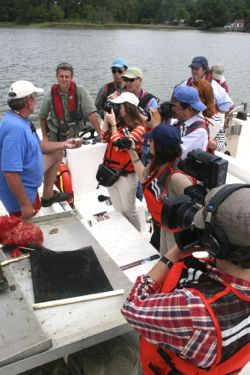
Dr. Anu Frank-Lawale of VIMS’ Aquatic Genetics and Breeding Technology Center showed the group through the VIMS Oyster Hatchery while explaining ABC’s role in developing the disease-tolerant and market-friendly oysters that are helping to revolutionize commercial and recreational oyster harvesting in Chesapeake Bay. The annual “Shellfish Aquaculture Situation and Outlook Report”—published by VIMS and Virginia Sea Grant—shows that Virginia growers sold 28.1 million oysters in 2012, a 21 percent increase from the previous year.
The reporters ended their day—appropriately enough—by adding to Virginia’s oyster sales for 2013, stopping at Merrior, a oyster tasting house on the banks of the Rappahannock River during their return bus ride to Washington, D.C.
“It was a fitting end to a day that the reporters thoroughly enjoyed,” says Rider.

